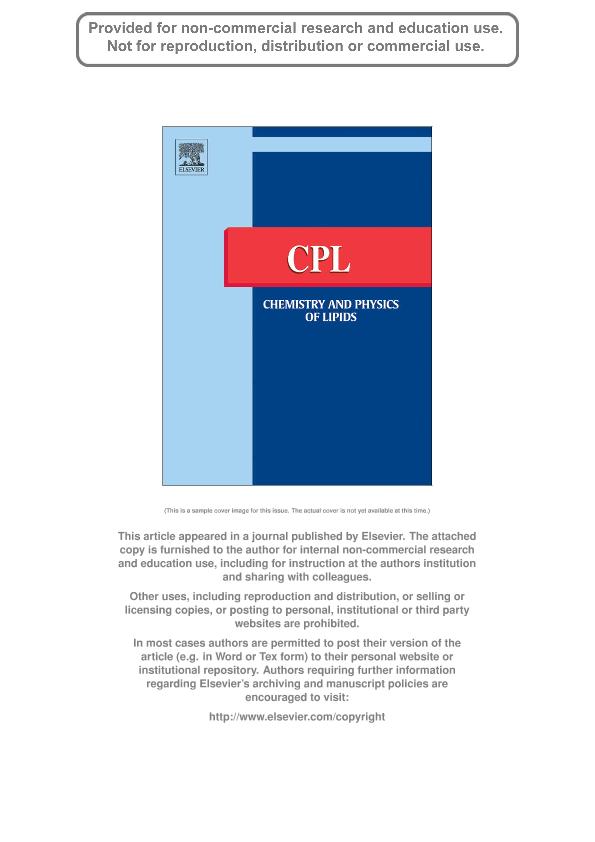Mostrar el registro sencillo del ítem
dc.contributor.author
Temprana, Carlos Facundo

dc.contributor.author
Duarte, Evandro L.
dc.contributor.author
Femia, Lis

dc.contributor.author
Alonso, Silvia del Valle

dc.contributor.author
Lamy, M. Teresa
dc.date.available
2022-08-02T12:46:04Z
dc.date.issued
2012-12
dc.identifier.citation
Temprana, Carlos Facundo; Duarte, Evandro L.; Femia, Lis; Alonso, Silvia del Valle; Lamy, M. Teresa; Structural effect of cationic amphiphiles in diacetylenic photopolymerizable membranes; Elsevier Ireland; Chemistry and Physics of Lipids; 165; 5; 12-2012; 589-600
dc.identifier.issn
0009-3084
dc.identifier.uri
http://hdl.handle.net/11336/163849
dc.description.abstract
Liposomes have been an excellent option as drug delivery systems, since they are able of incorporating lipophobic and/or lipophilic drugs, reduce drug side effects, increase drug targeting, and control delivery. Also, in the last years, their use reached the field of gene therapy, as non-viral vectors for DNA delivery. As a strategy to increase system stability, the use of polymerizable phospholipids has been proposed in liposomal formulations. In this work, through differential scanning calorimetry (DSC) and electron spin resonance (ESR) of spin labels incorporated into the bilayers, we structurally characterize liposomes formed by a mixture of the polymerizable lipid diacetylenic phosphatidylcholine 1,2-bis(10,12-tricosadiynoyl)-sn-glycero-3-phosphocholine (DC8,9PC) and the zwitterionic lipid 1,2-dimyristoyl-sn-glycero-3- phosphocholine (DMPC), in a 1:1 molar ratio. It is shown here that the polymerization efficiency of the mixture (c.a. 60%) is much higher than that of pure DC8,9PC bilayers (c.a. 20%). Cationic amphiphiles (CA) were added, in a final molar ratio of 1:1:0.2 (DC8,9PC:DMPC:CA), to make the liposomes possible carriers for genetic material, due to their electrostatic interaction with negatively charged DNA. Three amphiphiles were tested, 1,2-dioleoyl-3-trimetylammonium-propane (DOTAP), stearylamine (SA) and trimetyl (2-miristoyloxietyl) ammonium chloride (MCL), and the systems were studied before and after UV irradiation. Interestingly, the presence of the cationic amphiphiles increased liposomes polymerization, MCL displaying the strongest effect. Considering the different structural effects the three cationic amphiphiles cause in DC8,9PC bilayers, there seem to be a correlation between the degree of DC8,9PC polymerization and the packing of the membrane at the temperature it is irradiated (gel phase). Moreover, at higher temperatures, in the bilayer fluid phase, more polymerized membranes are significantly more rigid. Considering that the structure and stability of liposomes at different temperatures can be crucial for DNA binding and delivery, we expect the study presented here contributes to the production of new carrier systems with potential applications in gene therapy.
dc.format
application/pdf
dc.language.iso
eng
dc.publisher
Elsevier Ireland

dc.rights
info:eu-repo/semantics/openAccess
dc.rights.uri
https://creativecommons.org/licenses/by-nc-sa/2.5/ar/
dc.subject
CATIONIC AMPHIPHILE
dc.subject
DIACETYLENIC LIPID
dc.subject
DSC
dc.subject
ESR
dc.subject
POLYMERIC LIPOSOME
dc.subject
SPIN LABEL
dc.subject.classification
Física Atómica, Molecular y Química

dc.subject.classification
Ciencias Físicas

dc.subject.classification
CIENCIAS NATURALES Y EXACTAS

dc.title
Structural effect of cationic amphiphiles in diacetylenic photopolymerizable membranes
dc.type
info:eu-repo/semantics/article
dc.type
info:ar-repo/semantics/artículo
dc.type
info:eu-repo/semantics/publishedVersion
dc.date.updated
2021-07-30T19:16:37Z
dc.journal.volume
165
dc.journal.number
5
dc.journal.pagination
589-600
dc.journal.pais
Irlanda

dc.journal.ciudad
Amsterdam
dc.description.fil
Fil: Temprana, Carlos Facundo. Universidad Nacional de Quilmes. Departamento de Ciencia y Tecnología. Laboratorio de Biomembranas; Argentina. Consejo Nacional de Investigaciones Científicas y Técnicas; Argentina
dc.description.fil
Fil: Duarte, Evandro L.. Universidade de Sao Paulo; Brasil
dc.description.fil
Fil: Femia, Lis. Consejo Nacional de Investigaciones Científicas y Técnicas. Centro Científico Tecnológico Conicet - La Plata. Instituto Multidisciplinario de Biología Celular. Provincia de Buenos Aires. Gobernación. Comisión de Investigaciones Científicas. Instituto Multidisciplinario de Biología Celular. Universidad Nacional de La Plata. Instituto Multidisciplinario de Biología Celular; Argentina
dc.description.fil
Fil: Alonso, Silvia del Valle. Consejo Nacional de Investigaciones Científicas y Técnicas. Centro Científico Tecnológico Conicet - La Plata. Instituto Multidisciplinario de Biología Celular. Provincia de Buenos Aires. Gobernación. Comisión de Investigaciones Científicas. Instituto Multidisciplinario de Biología Celular. Universidad Nacional de La Plata. Instituto Multidisciplinario de Biología Celular; Argentina
dc.description.fil
Fil: Lamy, M. Teresa. Universidade de Sao Paulo; Brasil
dc.journal.title
Chemistry and Physics of Lipids

dc.relation.alternativeid
info:eu-repo/semantics/altIdentifier/url/http://www.ncbi.nlm.nih.gov/pubmed/22771924
dc.relation.alternativeid
info:eu-repo/semantics/altIdentifier/doi/http://dx.doi.org/10.1016/j.chemphyslip.2012.06.007
dc.relation.alternativeid
info:eu-repo/semantics/altIdentifier/url/https://www.sciencedirect.com/science/article/pii/S0009308412000771
Archivos asociados
